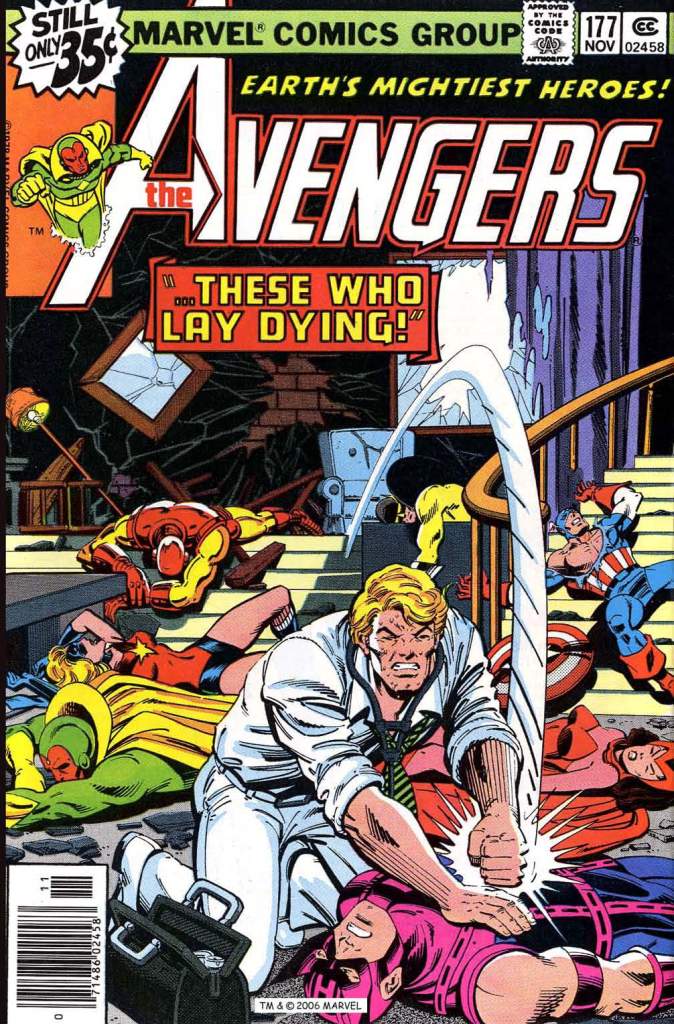
With this latest issue of AVENGERS, the ten-month-long Korvac Saga came to an end. Unfortunately, artist George Perez, who had been instrumental in convincing writer Jim Shooter to pen a storyline featuring all of the Avengers past and present, fell off abut a third of the way into the storyline, and it was plagued by some artistic instability as a result. Still, it was well received and well-remembered. This cover confused me as a kid when I first bought this issue. I interpreted it as showing Korvac striking his final blow against the Avengers. It wasn’t until much, much later that I realized that what it was really showing was Doctor Donald Blake, Thor’s human persona, desperately attempting to revive the fallen Avengers. It probably doesn’t help that both Blake and Korvac were nondescript white guys, and it’s not like this did any damage–I bought the book regardless. But I still see it that way for an instant whenever I first look at it, before my brain catches up and I’m able to interpret it properly.
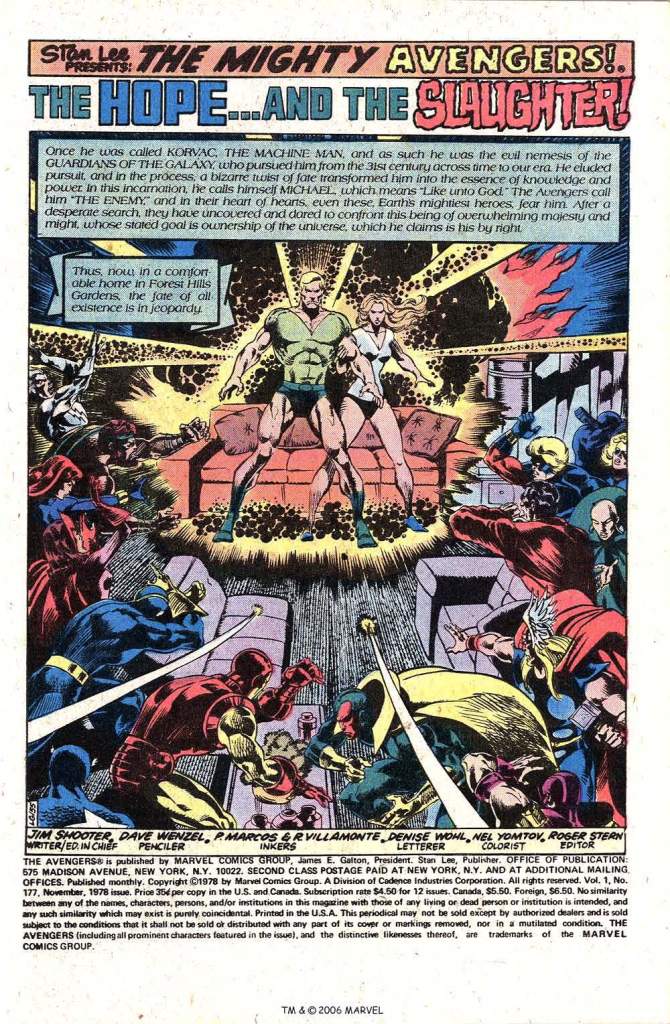
I’m pretty certain that I’ve covered this thought a couple of times while writing about the previous issues of this storyline that I read, but this is almost like the quintessential Jim Shooter story, one whose themes and ideas he’d return to again and again in different forms in years to come. And it can be interpreted in an oddly self-referential manner. There was something about the idea of a well-meaning person gaining ultimate power and intending to do good with it, but being opposed by champions who didn’t understand him or his motives and him being destroyed as a result that touched a nerve in Shooter. In that broadest sense, one can make the argument that this was Jim’s own trajectory as EIC of Marvel, and even in his term at Valiant. But that’s an outside perspective, I don’t know that Shooter was specifically relating to Korvac in that one-to-one fashion any more than he was to Captain America or Iron Man. But it sure is interesting how often that storytelling pattern reoccurred in his work.
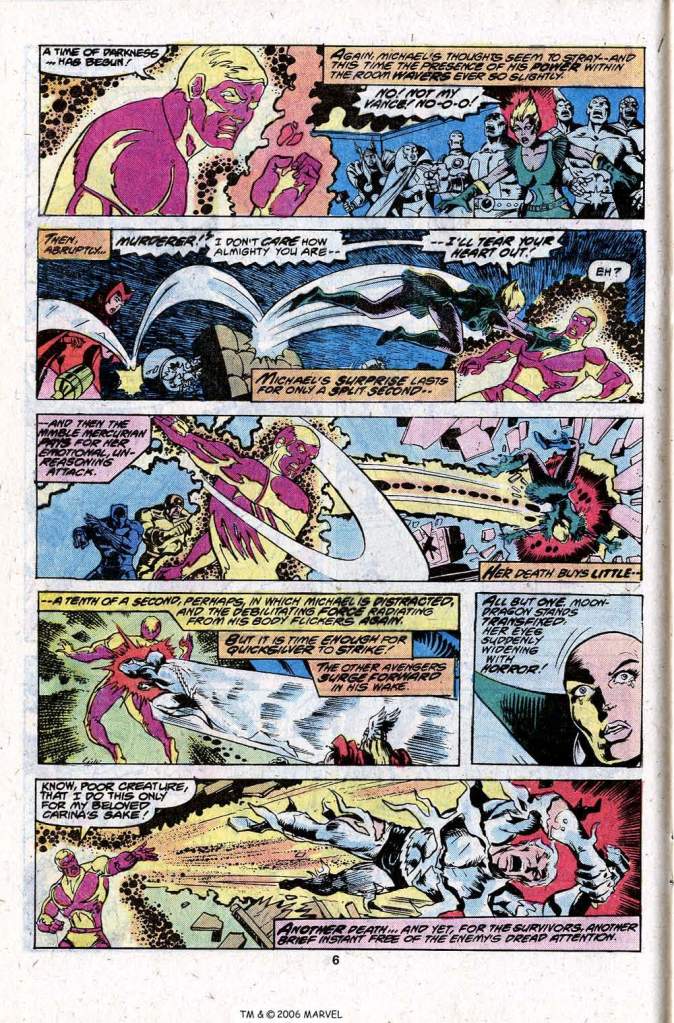
At the close of the previous issue, the assembled Avengers had located the Enemy, the Guardians of the Galaxy’s old foe Korvac from the future. Korvac had been reincarnated by the energies of Galactus’ World-Ship, turning him into a godlike being empowered with the Power Cosmic. Renaming himself Michael, he intended to work stealthily in order to change the Universe to make it more to his own liking. But now that he stands revealed by the Avengers, he knows that the great cosmic powers of the universe will also be aware of his presence, and will band together to prevent him from doing what he wants to do. And so, he’s plenty pissed at the Avengers, as well as the Guardians, who zip up right behind Earth’s Mightiest Heroes once they become aware that the team has found the Enemy. And that’s where the fireworks really begin.
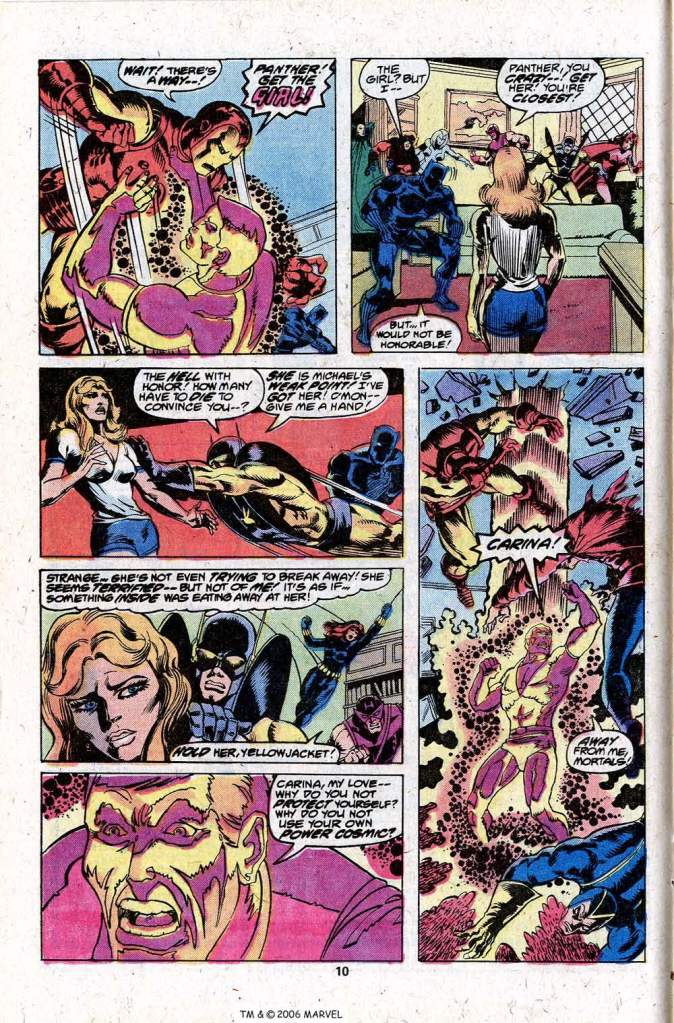
The issue is pretty much a book-long fight sequence, and a one-sided one at that. What made it memorable at the time was just how lethal it all was. As hero after hero strikes at Korvac, he swats them away dismissively, killing them. Yes, killing them–in a way no previous Marvel fight scene had gone, this is a bloodless bloodbath in which Avengers and Guardians are struck down and demised one after another. It almost reads like something out of What If–except that it’s “really happening.” Earlier, Michael had fallen in love with Carina, the daughter of the Collector who had been dispatched to spy on him for her father. Now, realizing that she represents Korvac’s only weak point, Yellowjacket tries to use her as a bargaining chip. This is another step in Hank Pym’s eventual turn as a character, though one that nobody could have realized at this moment. And the gambit fails, Michael simply kills Yellowjacket just as easily as the other heroes.
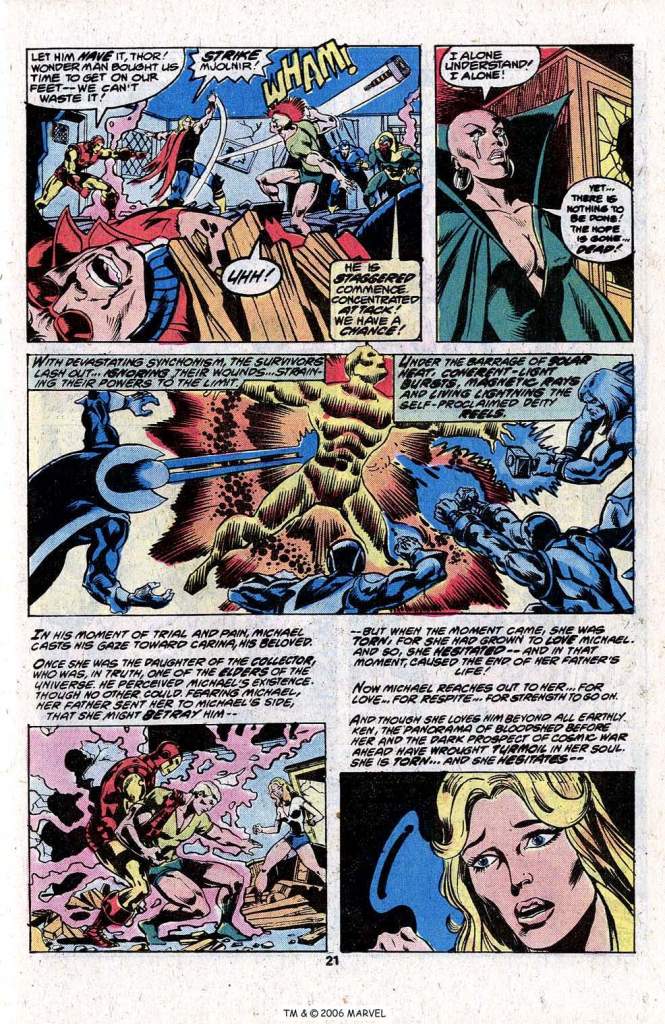
Finally, the battle comes down to just the strongest and sturdiest of the Avengers, and they strike as a unit. Korvac’s been burning through his Power Cosmic at a furious rate, so they’re able to stagger him a little bit. At a crucial moment, he glances over at Carina for emotional support–and just for an instant, she is afraid of him. This moment breaks Michael, and he suddenly stops fighting and slumps over, dead. Nothing the Avengers did to him was able to put a scratch on him, but the loss of the faith of his love causes him to in essence cease his own life.

Carina, though, flips out at this point and attacks the Avengers herself with her own cosmic power. She winds up killing a few, Iron Man and the Vision, until consumed with grief, she faces Thor. The Thunder God warns her to stand down or he’ll strike a killing blow. But Carina, remorseful for what she has done, wants to die, and she causes Thor’s hammer to strike without his will, killing her. As the dust settles, Moondragon, the telepathic Avenger, tells Thor that this was all a waste, that Korvac was truly not evil at all, and his plans would have been good for everybody, if only they’d understood him. And even there, in his final moment, Korvac reached out to restore all of the fallen Avengers to life. They’re grievously injured and in need of medical attention, but they’re all alive again. To attend them, Thor becomes Dr. Donald Blake once again, and Moondragon chooses to erase his knowledge of what she has just told him, so that he and the other Avengers will feel that they have won a great victory here, scarcely realizing the truth. And thus, the Korvac Saga ends.
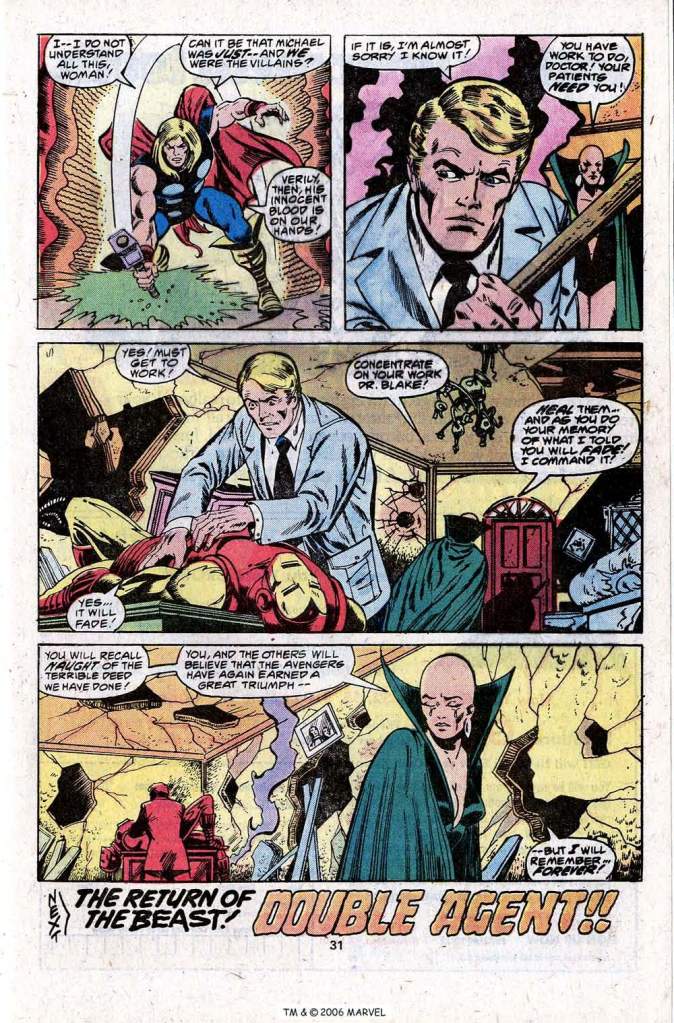
It’s a very truncated ending, and one that you’d expect to see followed up on in subsequent issues, as the Avengers recuperated from their injuries and the like. But such was not to be the case. For hereafter, what followed was a series of fill-in stories by other creative teams, as the book had been running so far behind schedule. And so this is as good a wrap-up as could be managed. Several years later, the first time this storyline was to be published in a Trade paperback collection, Mark Gruenwald decided to add an epilogue of three or four pages recontextualizing the story. In Mark’s estimation, in the way that he and others had later on sorted out the hierarchy of the Marvel cosmology, Korvac’s plan was foredoomed from the start–and that was the final point made by this epilogue, that even had Korvac gotten to do everything that he wanted, it wouldn’t have worked. His understanding of the universe was fundamentally flawed. This always read to me as a step too far, as a condemnation of Shooter rather than the story –Gruenwald had worked in editorial under Shooter and it was not typically a pleasant experience. And so, later, when I was in a position to do something about this, I had those pages pulled out of later editions. Flawed or not, Jim’s story should stand as it was written, without any latter-day editorializing in the story itself. (We do now tend to include the epilogue pages as bonus material in contemporary collections, separated from the main story and given some context.)

I remember at the time thinking it was Hank Pam performing CPR on Hawkeye.
LikeLike
You’re not the only one – I always think Hank Pym when I see this cover. Even though Don Blake makes much more sense… I guess it’s just unusual to see him ‘out of uniform’ with the Avengers. 🙂
LikeLike
I agree Tom — unlike the previous two posters, as a kid I always thought it was Korvac on the cover still beating up the Avengers (I didn’t understand CPR and whatnot).
By the way, thanks for letting us know how to reedited the edit. I think what you did made a lot more sense. Secret Wars be damned, the Korvac Saga was Shooter’s masterpiece. It should be read as is.
LikeLike
Wow! What a great summary. I just read the pages you posted and still remembered the effect this issue had on me as an 11 year old kid in 1978. I literally got goosebumps right now and teary eyed at age 55. This truly was a masterpiece of a saga and Shooter in my opinion couldn’t have ended it any other way. I agree that nobody should ever edit any reprints of this issue. The only thing I wish would have been different was the artist….I just wish it had been George Perez, not taking anything away from Dave Wenzel at all who I think did a great job filling in the last 3-4 issues of the saga. Tom, thanks for your post!
LikeLike
A well done summary. I don’t recall being confused by the cover as a kid… but it is an out-of-the-box editorial decision to focus on the aftermath of the story. Especially since in-story Blake seems oddly calm and detached getting to work on dozens of dying friends and acquaintances. He’s into it on the cover isn’t he?
I don’t think it was Shooter’s intention to have Michael be his proxy. I do think at some later point he possibly regretted that the ending taken at face value makes the Avengers and Guardians the villains of the piece. I don’t think the reader is supposed to think Moondragon’s last words about Korvac are the reasonable views of a hero… but it’s vague. There is that little slice earlier in the story where Moondragon forcibly alters Quicksilver’s thoughts which is also presented in a somewhat grey fashion. Later Shooter written stories involving Moondragon vs The Avengers would clearly portray her as the villain who would trade freedom for peace. … making whatever opinion she held about Korvac’s intentions retroactively wrong.
LikeLiked by 2 people
This is one of my favorite Avengers covers just by its stark difference to the usual. I did recognize that it was Don Blake right away with the doctor’s bag there but I’m guessing as a mid-teen I was older than the rest of you at the time.
LikeLike
I remember my first reaction to that cover was to wonder why they were showing the aftermath on the cover, when the whole book was a battle that was only just starting. Only later did I realize that basically made the covers of 175 and 176 into what this cover should have been.
I suppose it could have looked sort of like the 162 cover.
There was a WHAT IF—? issue a couple of years later that also tried to recontextualize the story. In it, Korvac did succeed, but he became so powerful that he basically went mad, and ended up destroying the entire universe via the Ultimate Nullifier. In other words, only in Shooter’s world does Korvac succeeding lead to a happy ending.
Also—this idea of a Shooter ending being redressed by later writers reminds me of the whole situation surrounding Avengers 200. I’ve had a good conversation with David Michelinie about *that*. (You can hear it at http://www.AvengersAssemble.net ).
LikeLike
The first episode I read of the Korvac storyline was #174. It was essentially a Hawkeye solo. But the concluding scene featured Korvac murdering his girlfriend’s father. The reasons were to protect his identity from being revealed, and to spite the girlfriend for her deceit in getting involved with him. Maybe certain comics fans think behavior of this sort is justified, but most people I think would view it and regard Korvac as an irredeemably despicable individual. They would see him as evil. They would see him as a villain. Jim Shooter conceived this scene. is there anything in his history of behavior that says he advocates murder, much less for such spiteful, paranoid, and egocentric reasons? Is there anything he has said in a voluminous amount of interviews that points in that direction? There isn’t. If you read the interviews, it is clear he sees Korvac as a villain. Any New Criticism-style close reading of the storyline says, that for all the story’s considerable flaws, one cannot see Korvac as anything other than evil and a villain unless one is desensitized to multiple instances of cold-blooded murder on the character’s part. Maybe the comics fans who want to portray Korvac as an alter ego for Shooter should think about their attitude when it comes to cold-blooded murder. Because it says a lot more about them than it does about him.
LikeLike
This whole story was artist proof so even without Perez it still worked. I liked Wenzel well enough. He could tell a clear story and showcase power. It’s a shame both inkers were very unsuited to his style but nothing could have dampened this finale anyway.
You mention that this was a start of where Hank Pym would end up. I agree and see also Moondragon starting down the path that led to her controlling a planet and Thor, killing her father, and then her experiences with the Defenders. It was as interesting as Pym’s journey but I’m glad Gillis and PAD rehabbed her more successfully afterwards than anyone has ever done for Pym.
LikeLike
I disagree about Hank Pym. Kurt Busiek did what was necessary at the end of the Ultron story in AVENGERS #22 (1999) to draw a line under his past to that point. I remember my utter dismay when, five years later, Chuck Austen undid all that. It’s why I dropped the title for many years. Later writers then just kept building on what Austen had done, essentially destroying Pym as a character that could ever plausibly be used as a hero again.
LikeLike
I used to think Chuck Austen was one of those popular writers I just didn’t get. Then I discovered how many people hate his work besides me.
LikeLike
I believe the trouble is the lack of powerful stories in Hank Pym’s history and the ability to mine drama from them. Spider-Man weathered slapping MJ because it was one event in decades of as big or bigger moments. Pym has basically The Slap. Englehart’s rehab, Busiek’s and Slott’s are all end points. New stuff with that status quo has to follow but Pym is basically a generic hero so it’s easier to go back to his instability.
LikeLike
I’ve always thought there was potential in Roger Stern having Hank say that it takes a strong man to shrink down to ant size and hold it together “and I was never that strong.” Though yeah, that’s also about the instability.
LikeLike
The story has much more power if we take Moondragon’s conclusion at face value, despite the points raised above. And Korvac’s goal to stop entities like Eternity and Odin messing around with mortals is a good one. The way later writers all recoiled from that felt to me less like a reasoned analysis and more a reflexive flinching from the idea the heroes massively screwed up (YMMV, obviously).
Steven Grant used the same twist to wrap up Omega’s story in Defenders — he was good, the Defenders screwed up — but it didn’t work as well.
LikeLike
Moondragon’s behavior in this episode–standing back, watching her fellow Avengers get slaughtered, and doing nothing to help them–is morally discrediting. I look at her at the end and see a character with a very messed up set of values. I’m certain that’s what Shooter intended. In the sequel to the Korvac story that he scripted for Avengers #219-200, he showed her efforts to carry on Korvac’s legacy. She proves quite a moral figure. She enslaves a planet, rapes Thor, and kills her own father.
LikeLike
There is an outrageous amount of copy on some of those pages wow. The last 2 panels on pg 21 kinda appear to have been tweaked to squeeze that text into the ultra wide gutters. This stands easily next to Secret Wars II as the most Shooter -ist of the Shooter works.
LikeLike
I knew it was Don Blake working to revive the fallen Avengers.
Perhaps because I was a little older (16 almost 17) when it came out? Or perhaps I was just a superior child who knew the way, not unlike Michael and Jim…
😉
LikeLike